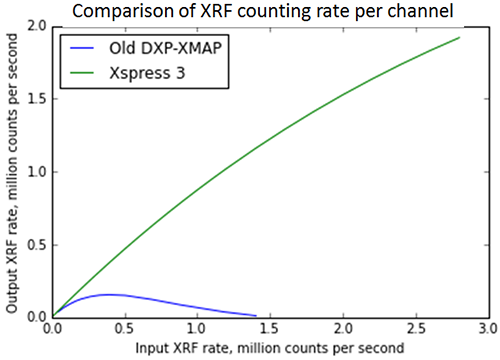X-RAY RUNS: Apply for Beamtime
2017 Nov 1 - Dec 21
2018 Feb 7 - Apr 3
2018 Proposal/BTR deadline: 12/1/17
2018 Apr 11 - Jun 4
2018 Proposal/BTR deadline: 2/1/18
Xspress 3, X-ray fluorescence (XRF) readout electronics made by Quantum Detectors, is one of the latest powerful instruments for high flux XRF detection used at synchrotron beamlines. With the capability of handling above one million counts per second per channel, the implementation of a 4 channel Xspress 3 for the Vortex ME-4 solid drift detector (SDD) at CHESS makes it easy to count multi-million counts per second of XRF. That is an increase of XRF counting rate by more than one order of magnitude comparing to the DXP-XMAP system we have been using for Vortex ME-4 SDD up to recently.
The capability of the high XRF counting rate makes it very meaningful to implement fly-scan of XRF measurement. This has been achieved simultaneously during the new instrument testing by CHESS staff Phillip Sorensen and Zachary Brown, with a modified CHESS motor driver, developed by CHESS staff Eric Edwards, which sends out motor timing signal as an acquisition trigger. With the Vortex ME-4 detector, the processing of XRF data has been handled by a user friendly GUI, Praxes, also home-developed by CHESS former scientist Darren Dale. By implementing fly-scan, the XRF spectrum file of large size is generated in HDF5 format, no longer the ASCII file format that Praxes was initially developed for. Therefore, Praxes has been upgraded at the same time by staff scientist Rong Huang to expand the capability to read spectrum file in this new format. Staff scientist Arthur Woll also offered his advice, and with team effort, the test running of this recently purchased instrument at CHESS F3 beamline during 2016-3 run went smoothly on every implementation, including experiments of X-ray absorption near edge structure (XANES), extended X-ray absorption fine structure (EXAFS), XRF mapping and XRF computed tomography. The successful implementation of Xspress 3 and XRF fly-scan greatly improved data quality, experiment efficiency, and the capability of each experiment.
 Figure: Comparison of XRF counting rates between one channel of Xspress 3 and one channel of old DXP-XMAP, measured at CHESS F3 beamline. While the maximum count rate the XMAP can handle is only around 100K counts per second, this number is way above 1 million for each channel of Xspress 3. With a 4 channel Xspress 3 and a 4 element Vortex detector, it becomes easy to handle XRF counting rate of multiple millions per second. This high counting rate not only improves experiment efficiency, but also extends data quality and experiment capability for XANES, EXAFS (in fluorescence mode), XRF mapping and XRF computed tomography.
Figure: Comparison of XRF counting rates between one channel of Xspress 3 and one channel of old DXP-XMAP, measured at CHESS F3 beamline. While the maximum count rate the XMAP can handle is only around 100K counts per second, this number is way above 1 million for each channel of Xspress 3. With a 4 channel Xspress 3 and a 4 element Vortex detector, it becomes easy to handle XRF counting rate of multiple millions per second. This high counting rate not only improves experiment efficiency, but also extends data quality and experiment capability for XANES, EXAFS (in fluorescence mode), XRF mapping and XRF computed tomography.
Submitted by: Rong Huang, CHESS, Cornell University
01/06/2017
